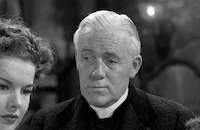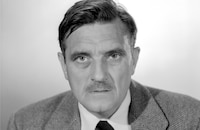Undercover Maisie

Brief Synopsis
Cast & Crew
Harry Beaumont
Ann Sothern
Barry Nelson
Mark Daniels
Leon Ames
Clinton Sundberg
Film Details
Technical Specs

Synopsis
At Los Angeles' Union Station, Maisie Ravier is about to board a train to New York to take a job as a bubble bath demonstrator when she meets Mrs. Andrew Lorrison, a confidence artist who offers to drive her there. Maisie accepts the offer but soon finds herself stranded without her baggage at a roadside diner when Mrs. Lorrison abandons her. Maisie reports the crime to Lt. Paul Scott of the Bunco and Fugitive Division of the Los Angeles police department, and her exceptionally detailed description of the suspect convinces Paul that Maisie would make a good detective. Paul later tells police captain Mead that Maisie is the right person to help them break up various confidence rackets in the city, and Mead agrees to send her to the police academy for training. Maisie joins the bunco squad as the only female officer in the department, and her presence soon causes a distraction among the male officers in her special training class. As a result, Maisie is taken out of the class and assigned a private tutor, officer Chip Dolan. Chip and Paul are both attracted to Maisie, and they compete for her attentions while teaching her how to be an effective undercover detective. Maisie's first case involves a young woman named Viola Trengham, whose mother has been swindled by a confidence artist known as Amor. Amor, who is posing as a fortune-teller and whose real name is Willis Farnes, is the head of a real estate scam. Maisie begins her investigation into Farnes's racket by posing as a prospective client and going to his house for a fortune reading. When Maisie tells Farnes that she needs advice on how to invest a large sum of money, Farnes goes into a fake trance and advises her to take the first offer she receives from an investor. Later that night, Gilfred I. Rogers, one of Farnes's accomplices, poses as a real estate agent and offers Maisie an apartment for a down payment of $20,000. Maisie invites Rogers to her apartment and feigns interest in his real estate deal, while Paul works on a plan to trap the confidence artists in action. The plan is foiled, however, when Maisie accidentally reveals her identity to Rogers. When Farnes discovers that he is being investigated by the police, he decides to move his confidence racket out of town after the next big swindle. Meanwhile, Maisie finds some papers that Rogers dropped in her apartment, including an invitation to a banquet hosted by Farnes. Later that night, while snooping around the banquet, Maisie is discovered by Farnes and his accomplices, who tie her up and hold her captive at their hideout. Maisie devises a clever plan to tip off the police as to her whereabouts, but the police pick up the clues too late and arrive at the hideout after Farnes and his gang have left for Long Beach with Maisie. En route to Long Beach, Jane and Guy Canford, two of Farnes's accomplices, double-cross Farnes and knock him unconscious. While the Canfords plan to kill Maisie at a remote roadside location, Maisie leaves her petticoat on a sign post along the road to indicate to the police the direction they are traveling. The Canfords eventually find a satisfactory place to kill Maisie, but Paul locates Maisie in time to save her, and the criminals are arrested.

Director

Harry Beaumont
Cast

Ann Sothern

Barry Nelson
Mark Daniels

Leon Ames

Clinton Sundberg
Dick Simmons

Charles D. Brown

Gloria Holden

Douglas Fowley

Nella Walker
Gene Roberts
Celia Travers

Morris Ankrum

Edward Keane

Ray Teal
Rudy Wissler
Hal Hackett
Sammy Mckim
Bill Shannon
Marvin Jones
Jack Wagner

George Mann

Lee Phelps
Charles Marsh
Robert Emmett Keane
Philip Ahlm
Bert Davidson
Jack Shea
Brick Sullivan
Jean Del Val

Ralph Dunn
Jack Lee
Charles Bradstreet
Bob Pepper
Fred Aldrich
Carl Saxe
Mickey Martin
John Wald
Eugene Sigaloff
Minerva Urecal
Dave Paris
Mickey Mcguire
Crew
Jack Dawn
Cedric Gibbons
George Haight
Irene
Ben Lewis
Charles O'malley
Thelma Robinson
Charles Salerno Jr.
Gabriel Scognamillo
Douglas Shearer
David Snell
Edwin B. Willis

Film Details
Technical Specs

Articles
Undercover Maisie
By Violet LeVoit

Undercover Maisie
TCM Remembers - Ann Sothern
TCM Remembers - Ann Sothern
Quotes
Trivia
Notes
The working title of this film was Bunko Maisie. The film was the last in the "Maisie" series. For additional information on the series, consult the Series Index and see the entry for Maisie in AFI Catalog of Feature Films, 1931-40; F3. 2662.















